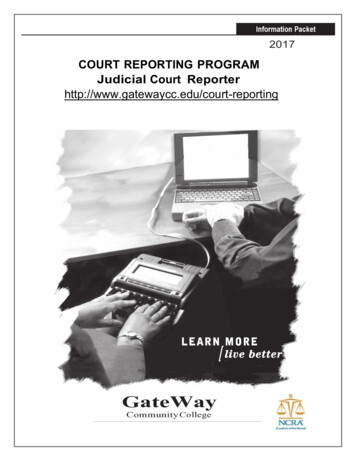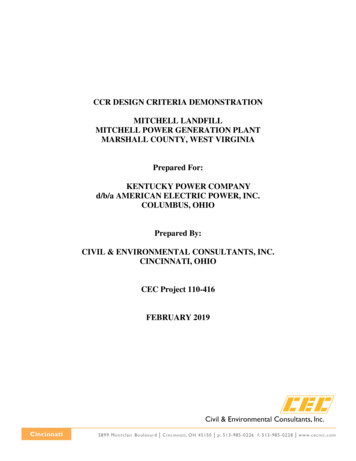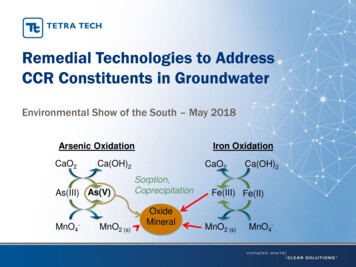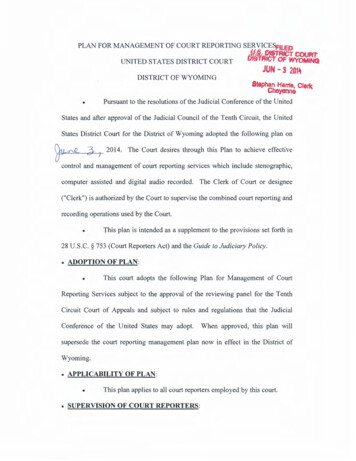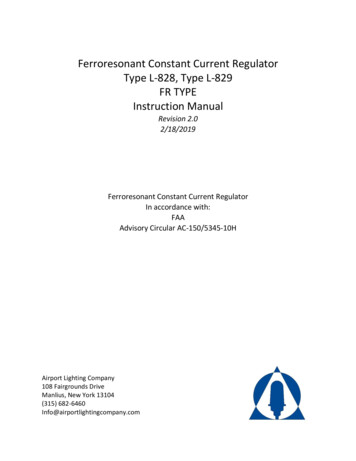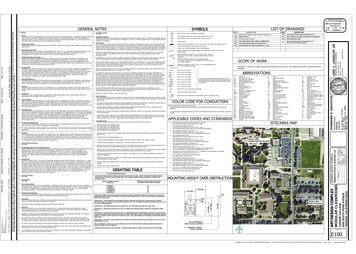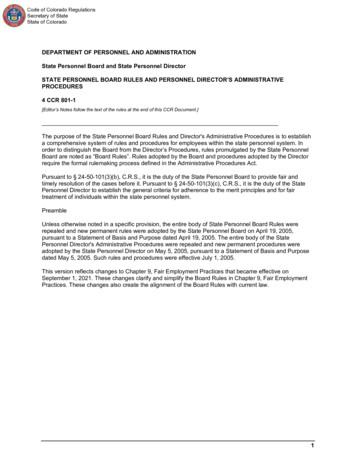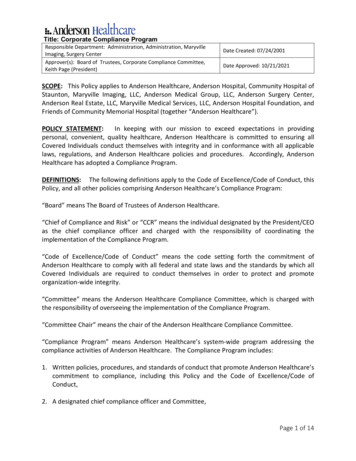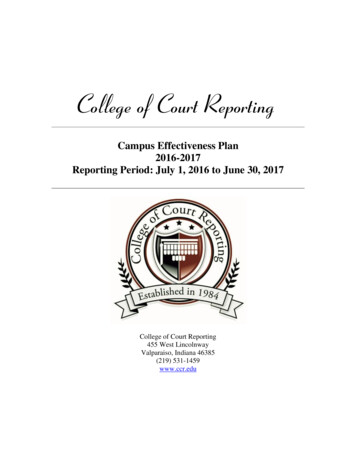
Transcription
College of Court ReportingCampus Effectiveness Plan2016-2017Reporting Period: July 1, 2016 to June 30, 2017College of Court Reporting455 West LincolnwayValparaiso, Indiana 46385(219) 531-1459www.ccr.edu
Table of ContentsI.Introduction and CEP HistoryII.The Campus Effectiveness TeamIII.The AdministrationIV.Mission and ObjectivesV.Student DemographicsVI.Program CharacteristicsVII.RetentionA. Retention Rates – HistoricalB. Retention Rates – GoalsC. Responsibility for RetentionD. Retention Activities and MeasurementsVIII.PlacementA. Placement Rates – HistoricalB. Placement Rates – GoalsC. Responsibility for PlacementD. Placement Activities and MeasurementsIX.Student Learning OutcomesA. Standard Academic ProgressB. Student RecognitionC. Program Learning Measurements and Assessment Tools/CriteriaD. Curriculum Review and ChangeX.Graduate SatisfactionA. Exit InterviewsB. Graduate and Alumni SurveysC. Recent Graduates Employment and Earnings SurveyXI.Employer SatisfactionA. Internship EvaluationsB. Employer SurveysXII.Evaluation of the CEP
I.Introduction and CEP HistoryThe College of Court Reporting is located in Hobart, Indiana. Classes began inSeptember 1984. The college was granted full accreditation by the IndianaCommission on Proprietary Education (ICOPE) on January 1, 1985, and was grantedapproval to award an associate of applied science degree in court reporting by thesame commission on August 14, 1985. The college became accredited by theAccrediting Council for Independent Colleges and Schools (ACICS) to awardcertificates and occupational associate degree diplomas in September 1989. Thecourt reporting program was granted approval by ACICS May 23, 2001, to bedelivered through online distance education. The medical transcription program wasinitially approved on May 18, 1994, but discontinued in June 2007 due to limited jobopportunities within the Northwest Indiana region. In March 2009, ICOPE accreditedtwo new programs: Voice Captioning Certificate and Court Reporting Diploma.Those two new programs were approved by ACICS in August 2009. The school wasincorporated by the State of Indiana September 3, 1985. Kay Moody is the college’sfounder; Jeff Moody is the corporation president and owner.The College of Court Reporting (CCR) was granted approval for the day program bythe National Court Reporters Association (NCRA) November 1, 1987, and becameNCRA’s first online certified program in the spring of 2006.The executive director and faculty development coordinator are responsible fordirecting, monitoring, and executing the Campus Effectiveness Plan (CEP) with theassistance of the president, director of education, and every administrator and facultymember.The purposes of the CEP are to ensure that the college is consistently evaluating itselfin order to promote the continuous improvement of educating our students througheffective teaching and faculty development; to exceed occupational objectives as itrelates to the needs of prospective employers; to achieve internal effectiveness; toassess progress, change, and improvement; to communicate outcomes; to demonstrateregulatory compliance; and to ensure quality assurance and effectiveness. Thefollowing areas are examined as part of the CEP: retention, placement, studentlearning outcomes, graduate satisfaction, and employer satisfaction. Data as it relatesto each of these specific areas are constantly evaluated and analyzed to assist theadministration with goal setting and fulfillment of the CEP’s purpose.To ensure overall campus effectiveness and CEP monitoring and implementation,aspects of the CEP are consistently discussed during monthly faculty meetings as wellas weekly administrative meetings. Evaluating data periodically during the year andannually are extremely important to assure quality assessment and effectiveness,improvement, and goal setting for the entire college. This constant evaluation
positively affects retention, placement, student learning outcomes, graduatesatisfaction, and employer satisfaction. These are the core elements to determineeffectiveness, thus, the necessity for consistent discussion and evaluation.CCR is will be relocating to its new building in Valparaiso, Indiana, in December2016. The CCR team will continue prioritizing mission achievement and also preparefor the move. The new building will be a complete renovation of an existing structureand will include state-of-the-art technologies.II.The Campus Effectiveness TeamThe specific members of the CEP team are the executive director, Jay T. Vettickal,and the faculty development coordinator, Janet Noel. Besides informal and formalCEP items discussions during weekly scheduled administrative meetings, the CEPteam has a goal of meeting three times annually at the beginning of each semester toreview and evaluate the CEP. An annual review and evaluation of the CEP, andsetting of yearly goals, is completed during the Annual Planning Meeting typicallyheld in June or July. Although formal meetings are scheduled to evaluate the CEP,the administration discusses areas related to the CEP during monthly faculty meetingsas well. The executive director is responsible for updating the CEP on an ongoingbasis.The CEP team met in June 2016 to develop the plan for July 1, 2016, through June30, 2017, and to evaluate data and results related to the previous CEP. All reporteddata that follows coincides with three full semesters ending in September 2016,January 2017, and May 2017. The team will meet again in the summer of 2017 tocreate specific objectives related to all campus effectiveness criteria for upcomingreporting year: retention, placement, student learning outcomes, graduatesatisfaction, and employer satisfaction.III.The AdministrationThe administrators work collectively with the faculty to promote campuseffectiveness. The size of the college allows the administration to adjust policies andprocedures related to campus effectiveness fairly quickly. The administrators consistof the president, the executive director, the director of education, the financial aiddirector, the faculty development coordinator, the director of student services, theadmissions director, the financial aid officer, the online consultant, the studentdevelopment specialist, and the graduate and employer relations coordinator. Theadministrators meet formally on a weekly basis to discuss all issues related to thecollege. These issues include campus effectiveness, student and faculty relations,day-to-day operations, operations, retention, etc.
IV.Mission, Goals, and ObjectivesA. Mission StatementCCR continuously reviews its mission statement to ensure that it is relevant andachievable. CCR made a strategic decision to change its mission statement whilepursuing accreditation with a new accrediting body. The following is the revisedmission statement:The mission of the College of Court Reporting is to provide state-of-the-artinstructional systems technologies and quality teaching techniques to educatestudents in the fields of realtime captioning and court reporting in an onlineenvironment. The College of Court Reporting is committed to providing a qualityeducation to students that meet or exceed the standards of the National CourtReporters Association and the National Verbatim Writers Association.B. Goals and How They are AchievedTo fulfil the mission, the goals of CCR are to provide students with an educationthat exceeds industry standards and to place graduates with gainful employmentin the fields relating to court reporting and realtime technology. The College ofCourt Reporting accomplishes these in the following manner: An intensive curriculum is offered as required by the National CourtReporters Association and recommended by the National Verbatim ReporterAssociation to train future realtime court reporters. The curriculum is revisedin accordance with the professional organizations and employers.The college creates an educational environment providing the learningexperiences necessary to enter the workplace. Courses of study are reviewed,revised, and added when needed. Students are given hands-on experience inrealtime computer-aided transcription and computer applications for the courtreporter, captioner, and (CART) provider.The entire staff recognizes the responsibility of encouraging each student tosucceed academically and to grow professionally to meet the challenging andchanging needs of realtime technology, court reporting, and realtime reportingfor deaf and hard-of-hearing individuals.The college strives to improve its programs with the latest informationtechnologies and teaching methods.The full court reporting curriculum is offered online over the Internet usingCCR’s proprietary learning management system that was created anddeveloped to meet the unique needs of court reporting education.An Associate of Applied Science degree and diploma for court reporting,along with a certificate for Voice-to-Text Captioning are offered by meetingthe requirements of the Indiana Board of Proprietary.
V.An environment is present whereby all students are given hands-on experiencein mock trials, hearings, and internships before entering the marketplace.Faculty are employed with qualifications and work experience necessary toteach. In addition to many possessing a bachelor’s degree or higher, mostinstructors possess court reporting certification: Registered ProfessionalReporter (RPR), Certified Shorthand Reporter (CSR), Certified ReportingInstructor (CRI) of the National Court Reporters Association, or CertifiedVerbatim Reporter (CVR). Certified instructors earn college and continuingeducation credits whenever possible.Students are encouraged to attain and maintain the highest possible standardsin their professional, academic, and private affairs. They are encouraged andprepared to attain court reporting certification (CSR or RPR), even thoughcertification is not required by the State of Indiana for employment as a courtreporter.Students are encouraged to continue their education and training beyondschool by taking college courses and joining professional organizations, suchas the National Court Reporters Association, National Verbatim ReportersAssociation, Indiana Shorthand Reporters Association, Illinois CourtReporters Association, or their respective state court reporting associations.They are encouraged to attend seminars and conventions and engage in avariety of continuing education and lifelong learning opportunities.Student DemographicsThe College of Court Reporting is located in Hobart, Indiana, which is approximately40 miles southeast of Chicago, Illinois. The majority of students at the college arefemale, with the data submitted from the 2016 Campus Data report supporting thisand showing 95 percent female and 5 percent male students.Additional data was reviewed from the college’s database to determine the make-upof the college students based on age, racial/ethnic classification, and years-in-school:
AGE 20-2122-2425-2930-3435-3940-4950-64RACIAL/ETHNIC known
YEARS-IN-SCHOOL CLASSIFICATION7060504030202016-2017100The following is a summary: Overall enrollment declined which is a occurring at all NCRA-approvedprograms.Most students fall into the 25 to 34 year range.There was a decline in the percentage of students in the 40 to 49 year range.The percentage of each racial category was consistent with the previous year.This was the first year that CCR tracked years-in-school. This will become avital piece of data as it relates to how effective the college is. The goal is to 90percent or more students in school for less than four years. This coincides withthe 44 month maximum time frame.The percentages represented in the graphs are very revealing in terms of studentdemographics. The typical College of Court Reporting student is a Caucasian femalebetween the ages of 25 and 39. This was the first year that the number of singlestudents exceeded the number of married students. The data also are reflective of ageneral relationship of the student body’s racial makeup to the U.S. racial makeupexcept for the number of Hispanic students.
VI.Program CharacteristicsAssociate of Applied Science Degree in Court Reporting OverviewCourt reporting students will complete the courses outlined below. Graduates areeducated for interesting and challenging positions of responsibility and trust asofficial, freelance, government reporters, and realtime reporters. Students receivingtheir Associate of Applied Science degree in Court Reporting must complete allrequirements for all classes.Students enrolled in court reporting and required academic classes for court reportingonline over the Internet meet the same requirements in all classes as students enrolledin courses onsite at the College of Court Reporting. This course of study meets orexceeds all requirements of the National Court Reporters Association. Students musttake at least 12 credit hours per semester to qualify as a full-time student.Court Reporting Associates Degree Core CompetenciesTo be eligible for an associate degree in court reporting, a student must meet thefollowing requirements:Earn 85 hours of credit for court reporting in machine shorthand, word processing,and other specified courses. The student must complete the following specificrequirements:o pass nine 5-minute dictation tests from unfamiliar material with atleast 95 percent accuracy in the following categories: three 180 literarytests, three 200 jury charge tests, three 225 testimony tests;o transcribe simulated CSR/RPR skills tests at 180 literary, 200 jurycharge, 225 testimony with no more than 3.75 hours transcription time(75 minutes per test);o transcribe a simulated Certified Realtime Reporter (CRR) test at 180200 words per minute for five minutes;o produce a ten-page, first pass transcript with 95 percent translationwithin two hours;o complete an internship consisting of 60 actual hours of writing time onthe shorthand machine and transcribe at least 50 pages from theinternship experience;o pass Communications, Foundations of Language and Writing, wordprocessing, Medical Terminology, Foundations of Law, CourtReporting Transcript Preparation, Court Reporting Procedures,Modern History, Culture & Society, Human Relations, Technology I,Vocabulary and Usage, an introduction to captioning course,CSR/RPR Preparation, and complete the court reporting internship.o Students must achieve an overall cumulative grade point average(GPA) of at least 2.0 in all courses completed.
Court Reporting Diploma OverviewCourt reporting students will complete the courses outlined below. Graduates areeducated for interesting and challenging positions of responsibility and trust asofficial, freelance, government reporters, and realtime reporters. Students receivingtheir Diploma in Court Reporting must complete all requirements for all classes.Students enrolled in court reporting and required academic classes for court reportingonline over the Internet meet the same requirements in all classes as students enrolledin courses onsite at the College of Court Reporting. This course of study meets orexceeds all requirements of the National Court Reporters Association. Students musttake at least 12 credit hours per semester to qualify as a full-time student.Court Reporting Diploma Core CompetenciesTo be eligible for an associate degree in court reporting, a student must complete 58credits and meet the following requirements:o pass nine 5-minute dictation tests from unfamiliar material with atleast 95 percent accuracy in the following categories: three 180 literarytests, three 200 jury charge tests, three 225 testimony tests;o transcribe simulated CSR/RPR skills tests at 180 literary, 200 jurycharge, 225 testimony with no more than 3.75 hours transcription time(75 minutes per test);o transcribe a simulated Certified Realtime Reporter (CRR) test at 180200 words per minute for five minutes;o produce a ten-page, first pass transcript with 95 percent translationwithin two hours;o complete an internship consisting of 60 actual hours of writing time onthe shorthand machine and transcribe at least 50 pages from theinternship experience;o pass Court Reporting or Realtime English, Realtime Technology,Court Reporting Processes and Development, Medical Terminology,Foundations of Law, Technology I, CSR/RPR Preparation, andcomplete the court reporting internship.o Students must achieve an overall cumulative grade point average(GPA) of at least 2.0 in all courses completed.Voice Captioning Certificate OverviewEnrollment in this program is limited. Upon successful completion of the voice-totext (voice) captioning certificate program, a student is educated to work as a voiceto-text broadcast captioner or communication access realtime translation (CART)reporter. Students should take at least 12 credits each semester, but they may take asmany as 17 credits.
Students enrolled online meet the same requirements in all classes as studentsenrolled in courses onsite at the College of Court Reporting. Students must take atleast 12 credit hours per semester to qualify as a full-time student. The following arethe program’s course requirements:Voice Captioning Core CompetenciesTo be eligible for a certificate in voice captioning, a student must earn 46 credits andmeet the following requirements:o Earn 46 hours of credit for voice-to-text speed development and otherspecified courses. The student must complete the following specificrequirements:o pass two recorded financial calls lasting 30 to 40 minutes fromunfamiliar material with at least 85 percent realtime accuracy;o complete an internship totaling 60 hours with 30 hours of supervisedvoice-to-text captioning and 30 hours of research for voice-to-text jobpreparation;o pass Court Reporting English, Introduction to Captioning, ComputerAided Translation for Captioning, Captioning Processes andDevelopment, Broadcast Captioning, Culture & Society, ModernHistory, and complete the captioning internship.o Achieve an overall cumulative grade point average (GPA) of at least2.0 in all courses completed.VII.RetentionA. Retention Rates – HistoricalCampus Retention Rates for the past four years were taken from the ACICSCampus Accountability Report as -14100%2015-201625%2016-201775%Court Reporting A.A.S.2011-1271%2012-1371%Court Reporting Diploma2011-12100%2012-1336%
Voice Captioning 679%2016-201783%Retention Rates – GoalsIn conjunction with the college’s Mission, retention is critical to campuseffectiveness as it demonstrates the college’s ability teach and provide all ofthe tools for students to progress through graduation. The college’s totalretention goal for the reporting period was 75 percent. This goal was set bythe CEP team and based on a marginal increase from previous reporting years.Institutional retention was 71 percent, thus, unchanged from the previous year.The retention rates for all three programs improved, while retention for thedegree program fell just below the institutional goal. CCR increased thenumber of students using the voice method in the diploma program, whichwas instrumental in the significantly higher retention rate in comparison to theprevious year.The CEP team will set a goal of 75 percent retention for the upcomingreporting year.B. Responsibility for RetentionStudent retention begins with the admissions process and is part of the dutiesof each employee. The executive director is responsible for tracking data andthe administrative staff works together to implement ideas and programs toincrease student retention. In order to proactively monitor student retentionon a weekly basis, all faculty are required to utilize the Student Alert! systemthat is part of the college’s proprietary EV360 Learning Management System(LMS) to notify all administrators of student issues. Faculty are responsiblefor contacting students and, if unsuccessful, the executive director or otheradministrators contact each student to develop a plan to get them on track.C. Retention Activities and Measurements1. As stated previously, student retention begins with the admissions process.The admissions director is required to explain not only the programsoffered but the rewards and challenges associated with each program.Prospective students are encouraged to contact current students, graduates,and professionals in order to gain an objective understanding of theprogram of interest.
The admissions department requires every student to take a preadmissions machine shorthand survey. This pre-admissions machineshorthand survey allows the admissions department the opportunity togather qualitative information regarding the student. This informationshared by the student gives the staff important information on the student'spersonal life, knowledge of English, and phonics. The instructors are ableto access whether the student will need additional assistance with Englishand phonics prior to classes beginning. In addition, the informationgathered aids in the staff and the faculty assistance in developing timemanagement plans, study tips, and techniques. A copy of the rm/form/9-admissionssurveyIn order to better understand the admissions process, the college sendseach newly enrolled student a survey:https://www.surveymonkey.com/s/CMJ9K2L. The purposes of the surveyare to determine the strengths and weaknesses of the admissions processand to improve on those processes. This survey provides the collegebenchmark data for both quality assurance and effectiveness with theadmissions process and overall retention.2. New student orientation is held prior to the start of each semester for newstudents. Onsite students meet all new fellow new students duringorientation to begin the camaraderie process. New online students meetwith fellow online students in a live Blackboard Collaboratesession\classroom for orientation.3.4.5.6.7.The admissions director and financial aid officer meet with all newstudents during the respective onsite and online new student orientationsto explain the college’s policies and procedures.The admissions department follows-up with each new student within thefirst two weeks of the semester start to determine whether each student’sexpectations are being exceeded.Students of the month are chosen during monthly faculty meetings.A monthly newsletter is published to include students of the month,monthly accomplishments of students, and articles featuring students andother items.The director of student services provides each administrator and facultymember a list of students on probation. All are responsible for assistingwith getting and keeping these students on track.Teachers are required to contact any absent students to help them to getcaught up.
8. Student evaluations of courses and teachers as well as the administrationare conducted each semester. The faculty development coordinatorreviews evaluations with each teacher. A minimum of one guest speakeris brought to the school each semester to help motivate students. Thesepresentations are available to all students.9. Operation Outreach at the beginning of the reporting period. The purposeof the meetings is to identify the common characteristics of at-riskstudents, work together to reduce the number, prevent students frombecoming at-risk, and develop a consistent and workable retention plan.VIII. PlacementA. Placement Rates – HistoricalPlacement rates for the past four years as reported on the CampusAccountability Report to ACICS are as 201683%2016-201782%Court Reporting A.A.S.2011-1281.3%2012-1389%Court Reporting Diploma2011-12100%2012-13100%Voice Captioning Certificate2011-12100%2012-1380%2013-14100%B. Placement Rates – GoalsPlacement rates are a direct measurement of college’s ability to fulfill itsMission. High placement rates are a strong indication that the college’s
educational activities are effective; however, long-term placement ofgraduates and positive feedback from employers are an even bigger indicationthat the college is meeting it’s the objectives of its Mission. The employerfeedback will be discussed in the Employer Satisfaction section.The overall placement goal for the reporting period was 90 percent. This goalwas set by the CEP team to reflect trends from previous years. The goal wasnot met but will remain the same for the upcoming year. CCR found arelatively larger number of graduates who are not aggressive with their jobsearch. The graduate and employer relations coordinator has had very limitedsuccess with motivating these graduates. This will continue to be a focus, as itnegatively impacts CCR’s effectiveness to achieve its misson.C. Responsibility for PlacementThe graduate and employer relations coordinator is responsible for graduateplacement.D. Placement Activities and Measurements1. Placement is the responsibility of the graduate and employerrelations coordinator. This person ensures that all studentsapproaching graduation are prepared for the career search.2. Internships are required for both court reporting programs and thevoice captioning program. The faculty development coordinatorassists court reporting students with internship placement, and theexecutive director assists the voice captioning students withinternship placement. Both individuals are networked in thecommunity and nationally. This allows our students easy access toprospective internships. Our experience has shown that moststudents receive job offers directly from their internship sponsors.3. The executive director also consults with advisory board membersand NCRA leadership to determine job availability, changes in themarketplace, etc.4. Placement data is included in each graduate’s student andelectronic file. Start dates, employer contact information, andposition are tracked. Overall data is reported annually to ACICSthrough the college’s CAR.IX.Student Learning OutcomesThe college’s Mission is represented in Student Learning Outcomes as itdemonstrates whether a student has the right educational environment to progress
and to graduate. The college strives to ensure that students are progressing asfollows:A. Standards of Satisfactory ProgressThe executive director, director of student services, and student developmentspecialist are responsible for monitoring standards of satisfactory progress. Atthe end of each semester, the director of student services reviews eachstudent’s semester GPA, cumulative GPA, speed progress, and percentage ofcredits completed. Students who do not meet any of the standards ofsatisfactory progress are notified by the director of student services. They arealso placed on a list that is given to all faculty and staff. The director ofstudent services goes over the list during each semester’s first faculty meetingto ensure that students on probation are closely monitored by each instructor.Percentages of students placed on probation out of total enrollment,percentages of students who met standards out of those placed on probation,and percentages of students who were terminated out of those who wereplaced on probation during the 2012-13, 2013-14, 2014-15, and 2015-16 CARreporting periods were as follows:Year2012-132013-142014-152015-16Placed inated45%36%36%35%We were pleased with the results. The college met its remediation goal of 65percent during the reporting year. The college set a goal of reducing thepercentage of students placed on probation to 25 percent for all studentsenrolled during the reporting period and achieved it with 22 percent. Thecollege will set a goal of preventing 67.5 percent of its students fromtermination during the upcoming reporting year, which is a marginal increase,and preventing 80 percent from going on probation, which is only 2 percentmore than the actual percentage during the reporting period.B. Student RecognitionStudent recognition is a motivating factor for student learning. In recognitionof this, the college promotes student excellence by honoring students withsignificant academic achievement each semester. The college’s honorsawards are presented each semester to students who achieve a semester GPAof 3.5 or higher. These students are listed in the college’s monthly newsletter
and local newspapers. Both the president and executive director also sign acertificate that is sent to each student achieving honors. The following showsthe percentage of students earning honors, high honors, and highest honorsduring the CAR reporting periods for 2012-13, 2013-14, 2014-15, and 201516:YearHighest Honors High Honors(GPA 3.9-4.0) (GPA 3.7-3.8)Honors(GPA 3.5-3.6)Percent of 2%21%5%5%5%8%37%40%38%40%10%8%11%12%The overall goal for the percent of students who achieve a semester GPA of3.5 or higher was 40 percent for the reporting year. This is based on historicaldata and providing students additional education tools that will promoteimprovements in student learning outcomes. The college did meet this goal. Ifthe college did not meet this goal, the administration would develop policiesand procedures to improve this student learning measurement starting with theupcoming CEP. The goal will remain at 40 percent for the upcoming year.C. Program Learning Measurements and Assessment Tools/CriteriaCourse and program learning tools are used throughout the college’scurriculum to establish Student Learning Outcomes. Benchmarks areestab
College of Court Reporting Campus Effectiveness Plan 2016-2017 Reporting Period: July 1, 2016 to June 30, 2017 College of Court Reporting 455 West Lincolnway Valparaiso, Indiana 46385 . CCR continuously reviews its mission statement to ensure that it is relevant and achievable. CCR made a strategic decision to change its mission statement while
